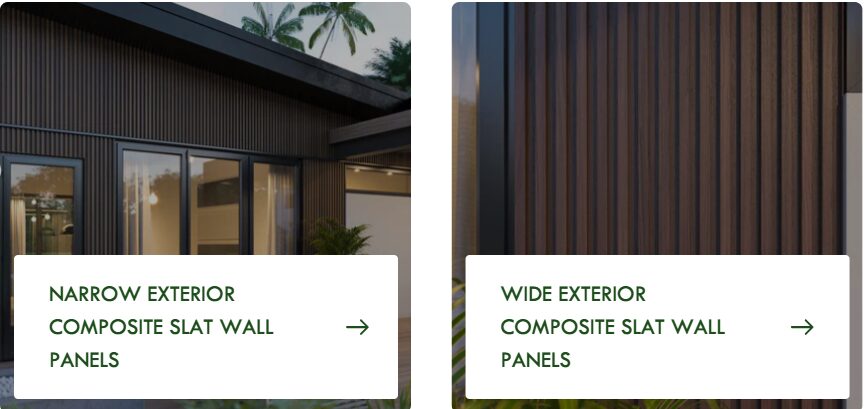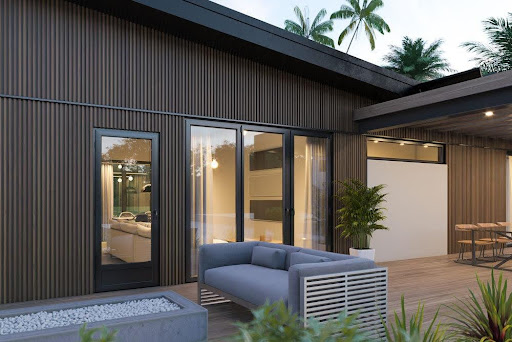Exterior composite slat wall panels have become a popular choice in modern architecture and construction due to their blend of aesthetic appeal, durability, and low maintenance. These exterior composite slat wall panels are designed to provide functional and decorative cladding solutions for building exteriors, combining advanced materials and innovative design to meet the demands of contemporary construction.
What Are Exterior Composite Slat Wall Panels?
Exterior composite slat wall panels consist of long, narrow strips or slats made from composite materials arranged horizontally or vertically to form an exterior wall surface. Unlike traditional wood slats, these panels use composite materials—typically a mix of wood fibers, plastic, and binding agents—that deliver superior performance in outdoor conditions.
The composite formulation ensures the panels are resistant to weather, rot, insects, and warping. The slatted design allows for effective ventilation, creating a visually appealing layered effect while also promoting airflow around the building envelope.
- Install Bathroom Wall Panels for Fast and Moisture-Resistant Coverage
- Durable Wall Panels and Steel Doors To Change Your Space
Key Materials Used in Composite Slat Panels
The term “composite” generally refers to engineered materials made by combining two or more components to achieve enhanced properties. For exterior slat wall panels, the following materials are commonly used:
- Wood-Plastic Composites (WPC): These are blends of natural wood fibers and recycled plastic, often polyethylene or polypropylene. WPC panels combine the appearance of wood with plastic’s durability and moisture resistance.
- Fiber Cement Composites: Some slat panels incorporate fiber cement, which mixes cement with cellulose fibers to create a highly durable, fire-resistant panel.
- High-Density Polyethylene (HDPE) and Other Plastics: Pure plastic composite panels offer excellent water and insect resistance and are often used in climates with extreme weather.
Each material choice affects the panel’s durability, appearance, cost, and maintenance needs, so selecting the right composite depends on project requirements and budget.
Advantages of Exterior Composite Slat Wall Panels
Composite slat panels offer several significant advantages over traditional materials like natural wood or metal cladding:
- Durability: Composite materials resist moisture, UV rays, insects, and rot far better than wood. This makes them ideal for outdoor use where weather exposure is intense.
- Low Maintenance: Unlike wood, composite panels do not require regular painting, sealing, or staining. Cleaning is generally simple with soap and water.
- Aesthetic Versatility: Composite panels can mimic the look of natural wood or other textures and come in various colors and finishes. The slatted design adds modern visual interest and can complement many architectural styles.
- Sustainability: Many composite panels use recycled materials and have a longer lifespan than wood, reducing the need for replacement and waste.
- Thermal and Acoustic Benefits: Composite materials often provide better insulation properties, contributing to energy efficiency. The slatted design also aids in sound diffusion.
- Easy Installation: Slat panels typically come in pre-fabricated sections that can be quickly mounted on exterior walls, reducing labor and installation time.
Applications of Exterior Composite Slat Wall Panels
The versatility of composite slat wall panels makes them suitable for a wide range of exterior applications:
- Residential Facades: Homeowners use these panels to add texture and style to house exteriors. The slatted design offers a contemporary look that can replace traditional siding.
- Commercial Buildings: Offices, retail outlets, and hospitality venues often incorporate composite slat panels to create striking facades that attract attention while offering durability.
- Fences and Privacy Screens: Composite slat panels are excellent for creating modern fencing solutions that provide privacy without feeling enclosed.
- Outdoor Structures: Pergolas, gazebos, and garden walls benefit from composite panels due to their resistance to weather and minimal upkeep.
- Accent Walls: For both commercial and residential settings, slat panels can highlight specific areas or architectural features.
Design and Installation Considerations
When choosing exterior composite slat wall panels, several factors influence the final outcome:
- Slat Dimensions and Spacing: The width and thickness of each slat, as well as the gap between them, affect both aesthetics and functionality. Wider slats create a bold look, while narrower ones offer subtle texture. The spacing controls ventilation and light passage.
- Orientation: Horizontal slats are common and emphasize the building’s width, while vertical slats can add height perception. Some designs combine both orientations for dynamic effects.
- Color and Finish: Composite panels come in natural wood tones, painted finishes, or custom colors. UV-resistant coatings ensure color longevity.
- Mounting Systems: Panels can be attached using concealed clips, screws, or track systems that allow for easy replacement and expansion. Proper mounting ensures stability and accommodates panel expansion due to temperature changes.
- Underlying Structure: A solid, moisture-resistant backing or frame is essential for supporting composite panels and preventing water ingress.
Maintenance Tips for Composite Slat Panels
Despite their low maintenance nature, exterior composite slat wall panels benefit from regular care to maintain their appearance and function:
- Cleaning: Use a soft brush or cloth with mild detergent to remove dirt and debris. Avoid abrasive tools that may damage the surface.
- Inspecting Joints and Mounts: Check periodically for loose slats or mounting clips and tighten or replace as needed.
- Preventing Mold and Mildew: In humid climates, ensure proper ventilation behind panels to reduce moisture buildup that can encourage mold growth.
- Avoiding Harsh Chemicals: Use cleaning products specifically recommended for composite materials to prevent discoloration or surface damage.
Comparing Composite Slat Panels to Other Exterior Cladding
While composite slat panels offer many benefits, it’s helpful to understand how they compare to other popular exterior wall materials:
- Natural Wood: Wood has unmatched natural beauty but requires high maintenance and is prone to rot, warping, and insect damage. Composite panels mimic wood’s look without these drawbacks.
- Metal Panels: Metal cladding is durable and sleek but can be prone to denting and heat conduction. Composites provide better insulation and a warmer aesthetic.
- Vinyl Siding: Vinyl is affordable and low maintenance but lacks the premium look and feel of composite materials.
- Fiber Cement: Fiber cement is durable and fire-resistant but heavier and more labor-intensive to install than composite panels.
Composite slat panels strike a balance between beauty, durability, and ease of installation, making them an attractive option for many projects.
Environmental Impact and Sustainability
Sustainability is an increasingly important factor in building material selection. Many composite panels are made using recycled plastics and wood fibers, diverting waste from landfills. Additionally, their long lifespan reduces the need for replacement, conserving resources over time.
Some manufacturers offer eco-friendly certifications and low-VOC coatings, contributing to healthier indoor and outdoor environments. When choosing composite panels, consider the environmental footprint as part of your decision-making process.
Cost Factors
The price of exterior composite slat wall panels depends on material quality, panel size, finish, and installation complexity. Generally, composite panels fall between vinyl and premium wood siding costs. Although initial investment may be higher than vinyl, the reduced maintenance expenses and longer life make composites cost-effective in the long run.
Trends and Innovations
Recent innovations in composite slat panels include:
- Enhanced Textures: Improved surface embossing creates panels that more closely resemble natural wood grains and other textures.
- Integrated Lighting: Some slat panels come with built-in LED lighting strips, enhancing architectural appeal and safety.
- Custom Shapes and Sizes: Advances in manufacturing allow for curved or irregular panel shapes, enabling unique architectural designs.
- Smart Materials: Development of composite panels with self-cleaning or anti-microbial properties increases their functionality.
Conclusion
Exterior composite slat wall panels offer a modern, durable, and aesthetically pleasing solution for building exteriors. Combining the benefits of composite materials with the timeless appeal of slatted designs, these panels cater to a broad range of architectural styles and functional needs. Their ease of installation, low maintenance, and environmental advantages make them an excellent choice for residential, commercial, and outdoor applications.
By understanding the types, benefits, design options, and maintenance needs of composite slat panels, property owners and architects can make informed decisions that enhance building performance and curb appeal for years to come.






























